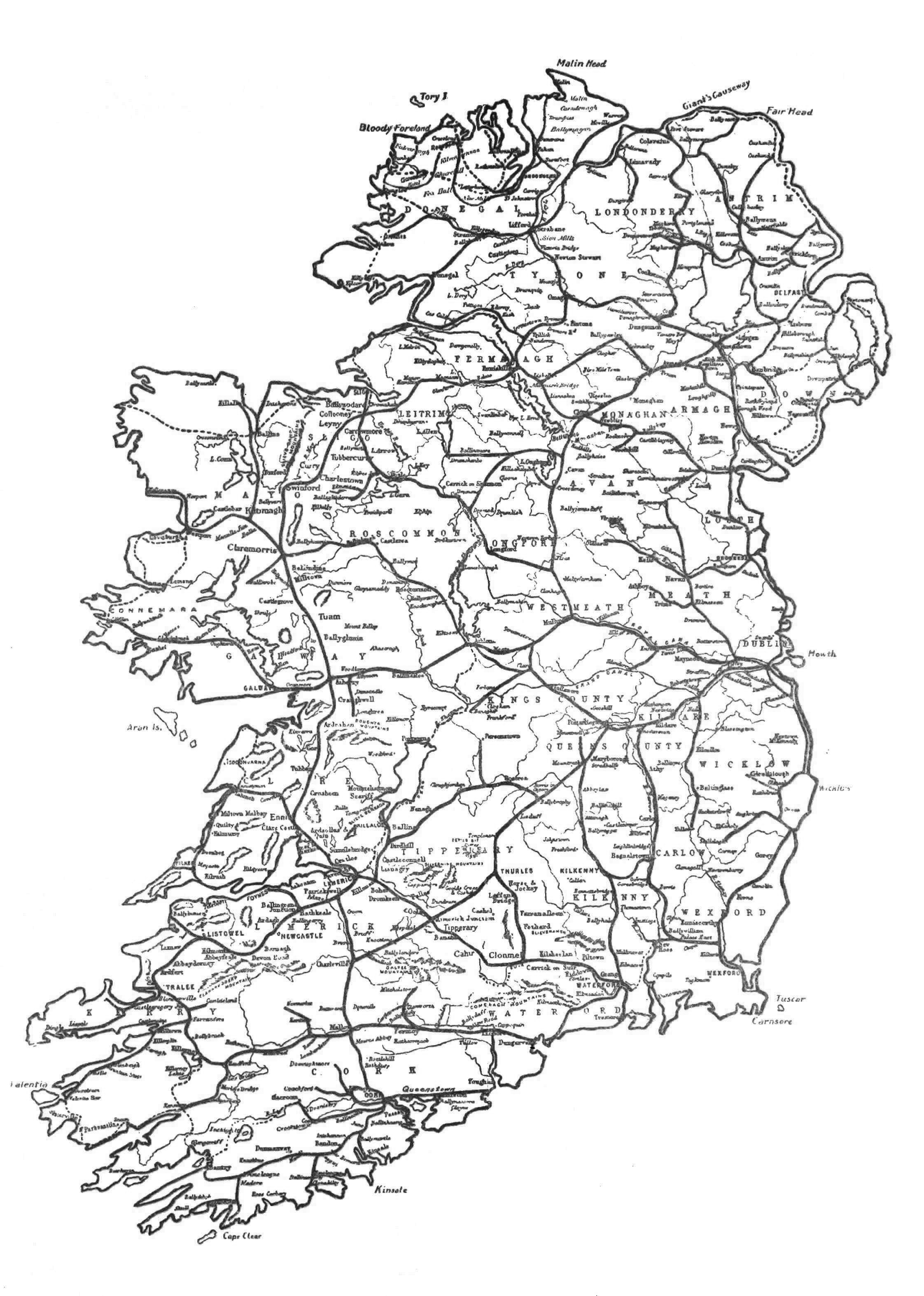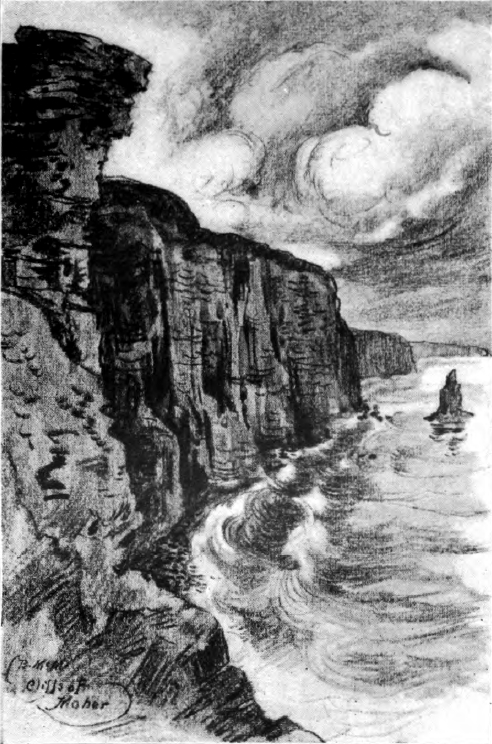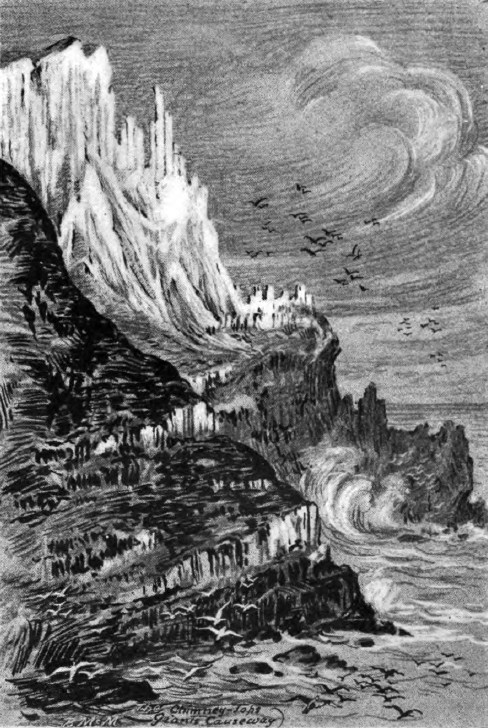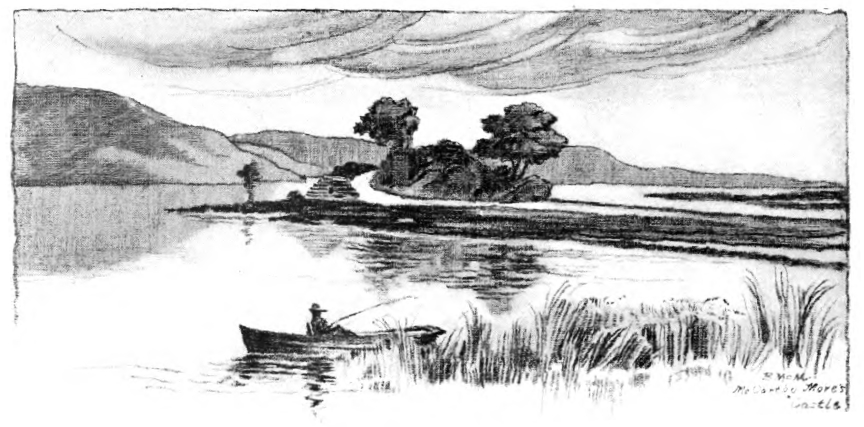| Web
and Book design,
Copyright, Kellscraft Studio 1999-2017 (Return to Web Text-ures) |
 (HOME)
|
|
CHAPTER II. A TRAVEL CHAPTER THE true peripatetic philosopher is the only genuine traveller, and the vagabond and the pilgrim are but varieties of the species. The “personally conducted,” alone or in droves, have no realization of the unquestionable authority by which nature “sets up her boundaries and fences; and so circumscribes the discontent of man,” to borrow the words of Sterne. The individual who merely wants to “get there” in the shortest possible time, and by the most direct road, knows not the joys of travel, nor ever will. The moods of the traveller are likewise a varied thing; circumstances never alter cases more than when met with unexpectedly by him who travels for business or pleasure. With Ireland the above singularly applies. Similar conditions must exist in order for one to see it in just the same phase. The Liffey, which flows through Dublin’s streets, may be dirty, picturesque, or beautiful according to whether you view it on one part or another. Blarney Castle does not look as if it were made to kiss, and so some are disappointed therein. Cork harbour is one of the most charming landlocked waters one may see; but, if he views it from Queenstown heights and is pestered meanwhile by a shabby, loafing beggar for an “American nickel or dime,” the onlooker will doubtless form a mental reservation which will linger as long as the lovely memory itself.
THE CHIMNEY-TOPS, GIANT’S CAUSEWAY Killarney may, or may not, come up to his preconceived ideas, and Slievemore, that majestic peak which towers sugar-loaf fashion quite two thousand feet from the water’s edge, may seem grim and bare where he would have found it forest-grown. The Giant’s Causeway, but for the recollection of its various legends, might suggest something quite different. And so the whole scheme, viewed in a pessimistic manner, leaves no such impression as otherwise would have been the case. For him, then, who would like his way smoothed, — his travel-routes laid down and simplified, — the present chapter, it is hoped, will be found acceptable. The approach to Ireland from England is, at best, not so very comfortable or attractive. The Holyhead mail-boats are so timed as to accomplish remarkable regularity of passage in all weathers, but, at times, with no little discomfort to passengers. The crossing from Holyhead to Kingstown is the Pas de Calais over again; with an exaggeration of length and, if possible, of boisterousness. It lasts two and three-quarters hours, and, in any but the most temperate mood of wind and wave, would be a good test of one’s fitness for a seafaring life. The passage from Stranraer to Larne is better, being less than two hours and not all of that in the open sea; while from Milford Haven to Waterford, in the south, is some six or eight hours’ journey; and that of Holyhead to Greenore, or Liverpool to Belfast, is worse in every particular. On the whole, Holyhead — Kingstown is the route which may best be followed, under normal conditions and circumstances, in reaching Ireland from England. Anglesea Island, on which is Holyhead, is the “Lands End” of North Wales and the natural gateway for reaching Ireland, hence it is a foregone conclusion that the route should be popular. Holyhead, itself, offers little suggestion of the dense forests of druidical times. It is popularly supposed to have been devastated by the Romans, who slaughtered those pitiless hierarchs, the druids, and put an end to human sacrifice — cutting down with sharp axes the sacred shady groves which once dotted the island.
 As the South Stack is left behind, — that beacon-light by which passes all of that vast sea-borne traffic to and from Liverpool via St. George’s Channel, — the mail-packet begins to find herself; and, in the course of time, wind, and tide, the greensward of Dalkey and the heights of Howth — guarding Dublin Bay on the north and south — come into view. It has seldom, if ever, been claimed that the shores of Ireland actually denote hospitality; in fact, it is doubtful if this be true of any land north of tropic climes. Dublin has not an ideal situation for a touring centre, in fact, it is not central at all; but it is the best that offers, and is the gateway through which by far the majority of travellers make their entrance. Four great topographical divisions lie north, south, and west of this gateway, and arrange themselves naturally enough along the boundary-lines of the ancient political divisions of Leinster, Munster, Ulster, and Connaught, which have descended in historical lore and association from the Irish kings. Each of these topographical divisions forms a centre of itself, and each is equally accessible from Dublin. In popular sentiment, the south, perhaps, stands at the head, with Connemara and the western highlands next, and lastly the colder north. The entire island is but three hundred miles in length by one hundred and eighty miles in width. Naturally such a circumscribed area offers but little difficulty for modern means of transport, and, did one but have the time and inclination, it would be hard to find a more entrancing journey on foot than to walk around the island along its wonderfully picturesque coast roads. This procedure will doubtless not be practicable to every one; but he who is able to do so is strongly recommended to so accomplish a portion of the round, if only that small portion which lies between Bantry and Killarney or Clifden, in Connemara and Sligo. If he would not tramp, he can find “car” accommodation in summer; or he may make the journey with much pleasure by means of his bicycle, or, more progressively, by motor-car. In any event, he will then see and realize to the full some of the things that the average person sees only in pictures, and reads of only in books. It is a question as to how far the casual traveller likes to be left to his own resources to discover new or latent beauties of landscape or environment; but, while the spirit of adventure need not necessarily be great in one’s soul, it is unquestionably with somewhat of the feeling that the old explorers must have had that one comes suddenly upon a vista miles and miles in extent, with perhaps not a sign of human habitation or of human life in any form to be noted in any direction. There may be other populous countries of Europe where this is equally possible, as well as Ireland, but assuredly not more so. There is in the two localities before mentioned, and in the Donegal Highlands, an isolation as primitive and unworldly as the mind of man, used to the civilization of cities, can possibly conceive; and, yet, all is within a couple of hours’ ride by rail of centres of population which, if not entitled to be classed as great cities, are resplendent with electric-lights and under the spell of motor-cars and electric lines. The railway routes, generally speaking, also readily lend themselves to this arrangement of the topographical divisions into the south, the north, and the west. Thus one may go to Cork either via Mallow, the junction for Killarney, or via the easterly coast through the “Garden of Wicklow,” Wexford, Waterford, and Youghal. Until Cork is reached, the tourist journeys rapidly or slowly, as the places en route may or may not have an appealing interest for him but, once Cork, or Mallow, is reached, he is put to it to decide his future movements with something of the precision of a time-table, depending on whether he has much or little of the well-recognized commodity of time at his disposal.  THE CLIFFS OF MOHER. To know and appreciate the full charm of that jagged corner of southwest Ireland which lies between Cork harbour — whence so many sunny-spirited Hibernians have migrated to America during the last fifty years — and Tralee, in County Kerry, one should journey around the coast by steamer. One week, not less, should without question be devoted to Killarney and about there, if one would enjoy it to the full, though the week can perhaps be made to include the tour between Dublin and Limerick, as well as the coach trip from Bantry Bay to Killarney via Glengarriff. Another week — it can hardly be accomplished in less time — should be passed between Limerick and Sligo, including Galway, Connemara, Achill, — that lone peak rising from the sea, — and such of the western highlands, in general, as it may be possible to cover in this time. A final week, all too short, may be given to the Donegal Highlands, the Giant’s Causeway, and around the coast to Belfast, whence one completes the round by returning to Dublin, or crossing to England by way of Greenore to Holyhead, Belfast to Liverpool, or Larne to Stranraer.
Such, in brief, is the general outline of the methods which will enable the traveller to make the round with the most economical expenditure of time and money. In the height of the season, July and August, — one should not, however, go anywhere in “the height of the season,” — there are charming variations of travel by lake or river, or coasting trips by steamer around the greater part of the island, which lend not only variety, but offer to some a more pleasant method than even travel by land. What the real travel-lover wants, however, is, or ought to be, to partake of the life of the people, to see and know truthfully how they live, what they eat, what are their pleasures and their vocations, and how and why they so conduct themselves. One does not tour France to eat tables d’hôte served after a conventional menu du jour, which is much the same the world over, or to America or England, or to Germany or Russia to do the same thing. What he really wants, or what he would really like, did he but know how to get it, or were he possessed of sufficient unconventionality, would be to eat snails in Burgundy, bouillabaisse in Marseilles, saddle of mutton in England, baked beans and pumpkin pie in New England, and the best of beef and hog products in Ireland. This last may sound a bit strange, but it is a fact that the larger number of bullocks brought to English ports for slaughter come from Ireland, and not from the Argentine or America, as the English fiscal reformers would have us believe.
The old though unidentified adage, “When in Rome do as the Romans do,” should be more largely applied by all whose province and wish it is to roam, as, for instance, “When abroad do as the natives do.” Thus, when in Ireland, keep away from the establishments which cater for the “tripper” pur sang; follow the unworn track, which, perhaps, will lead you now and then into a quandary, but which will mean no great hardship or inconvenience, and, on the whole, will give one a far more interesting and satisfying view-point than any other, and a knowledge of the land and the people which is positively profound, as compared with the usual variety. For the rest, it is urged that the traveller, either for education or pleasure, be forewarned and forearmed as to the possibility of time slipping away unawares, and his not being able to accomplish all of what he may have set forth to do. This will most likely be the case; but he should curtail his tour abruptly and not by piecemeal, omitting, if necessary, the northerly portion entire, and returning to Dublin from Galway or Sligo. By no means, however, should he cut out the western highlands, or even Achill, for here lies that which is, as yet, the part of Ireland least known to the great mass of tourists. It is taken for granted that he will feel that he must, happen what may, “do” the Killarney district; and, after all, if it is the most sentimental and daintily composed of all the land, it is not the less appealing to him who is strong of girth and rugged in his instincts. It is, moreover, the region wherein are to be found the most complete “creature comforts,” as civilization knows them, albeit the charges for them may in many cases rise to heights which are unknown outside of really fashionable tourist points. Still, in this respect, there has been a great improvement of late, and, unless one insisted upon surrounding himself with those more or less unnecessary adjuncts of a metropolitan life, — which he ought to have left behind him with his other cares, — he will find that, for simple and comfortable accommodation, he will need to pay no more than in that Mecca of the cheap tourist, Brittany. The hotel accommodations of Ireland have often been reviled; but, if not luxurious, they are at least as comfortable as in many other more popular regions, Brittany, North Spain, or Tuscany, for instance; and, while large and populous modern towns are not frequent, accommodations of an acceptable character are to be found in most places where the traveller has a right to expect them. The many and varied elements which make Ireland attractive unconsciously weave a spell which, mayhap, will allure many another to seek for himself the charm of Ireland, in preference to all other neglected tourist points. It certainly stands first and foremost as a new touring-ground for those who would not perforce wander too far afield, or at too remote a point from a metropolitan daily paper. Not that the mountain fastnesses or the isolated headlands and unfrequented lakes and loughs are always within quick communication with more populous centres of civilization. Far from it; one may journey many a weary hour from some remote hamlet in order to strike again the railway which is to take him to some newer and possibly more appealing centre of interest; and, when he reaches that same railway, or one of its newly made tentacles, which are for ever reaching out toward new lands to conquer, he may be forced to pass an equally lonely, though perhaps awe-inspiring, vigil at the base of some bald, bare mountain-peak, awaiting the main line connection which was due at this point a couple of hours before. All of which, were one imbued with anything but the spirit with which he ought to be imbued, might gall and chafe, with some sense of reason, but which, for the true vagabond, even though he may not choose to travel by foot and on the road, ought to be the very essence of enjoyment. |

